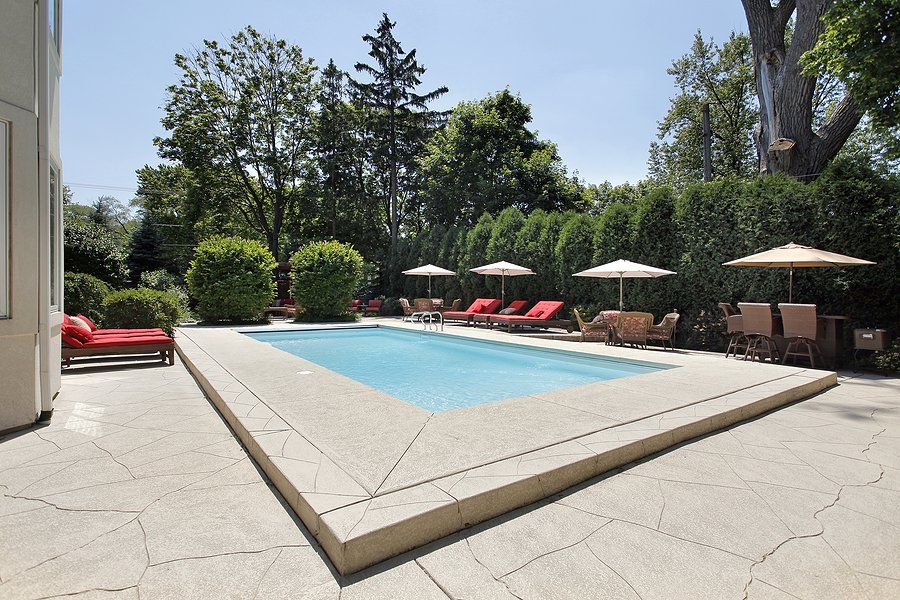Stamped Concrete Halifax
Stamped Concrete: A Comprehensive Guide by Halifax Concrete Refinishing
Stamped concrete has become an increasingly popular choice for both residential and commercial properties due to its versatility, durability, and aesthetic appeal. As a leading concrete contractor, Halifax Concrete Refinishing specializes in designing and installing high-quality stamped concrete in Halifax, providing our clients with a beautiful and long-lasting surface that mimics the appearance of more expensive materials like natural stone, brick, or wood. In this comprehensive guide, we will outline the steps involved in the design and installation of stamped concrete for various applications, including driveways, patios, and walkways.
- Initial Consultation and Site Evaluation
The first step in the process of creating a stamped concrete surface is the initial consultation. During this stage, a representative from Halifax Concrete Refinishing will visit your property to assess the area where the stamped concrete will be installed. This involves taking measurements, evaluating the soil conditions, checking for potential drainage issues, and identifying any obstacles that may need to be addressed, such as utility lines, tree roots, or existing structures. The concrete contractor will also discuss your design preferences, budget, and timeline to ensure that the finished stamped concrete surface meets your expectations.
- Design and Material Selection
Once the site evaluation is complete, the next step is to create a custom design for your stamped concrete project. Halifax Concrete Refinishing offers a wide range of design options, including various patterns, textures, and colors that can be achieved through different stamping techniques. You can choose from an extensive selection of stamp patterns that replicate the appearance of natural stone, brick, or wood, or opt for more abstract or geometric designs. The concrete contractor will work closely with you to select the perfect combination of materials and finishes that align with your desired aesthetic and complement your property's architecture.
- Site Preparation and Excavation
Before the stamped concrete can be poured, the site must be properly prepared. This involves clearing the area of any debris, vegetation, or other obstacles that may interfere with the installation. Depending on the size and scope of the project, this may require the use of heavy equipment such as excavators or skid-steer loaders.
Once the site is clear, the excavation process begins. This involves digging out the area where the stamped concrete will be installed, typically to a depth of 4-6 inches for a residential application and up to 8-12 inches for a commercial property. The excavation depth depends on factors such as soil conditions, local building codes, and the intended use of the stamped concrete surface. It is essential to achieve a consistent depth to ensure a stable foundation for the concrete slab.
- Grading and Compaction
Proper grading and compaction are crucial for the long-term stability and performance of your stamped concrete surface. After the excavation is complete, the ground must be leveled and graded to ensure that the surface will have a consistent slope for proper drainage. Typically, a slope of 1/8 inch per foot is recommended to prevent standing water and promote efficient water runoff.
Following the grading process, the soil must be compacted using a plate compactor or other specialized equipment. This step is essential to create a stable and firm base for the concrete slab, preventing future settling or cracking.
- Installation of Forms and Reinforcement
Once the site is properly graded and compacted, forms are installed to create the perimeter of the stamped concrete surface. These forms are typically made of wood or metal and are used to contain the concrete during the pouring process, ensuring that the slab is the correct shape and size.
In addition to forms, most stamped concrete surfaces require reinforcement to increase their strength and durability. This reinforcement can be in the form of steel rebar or mesh, depending on the specific requirements of the project. The reinforcement is strategically placed within the forms, where it will be embedded in the concrete during the pouring process.
- Pouring and Stamping the Concrete
With the forms and reinforcement in place, the concrete can now be poured. Halifax Concrete Refinishing uses high-quality concrete mixtures designed to withstand the specific environmental and usage conditions of your stamped concrete surface. The concrete is typically poured in sections, starting at one end of the surface and working towards the other.
As the concrete is poured, it is important to ensure that it is evenly distributed and fills the forms completely. A concrete contractor will use various tools, such as rakes, screeds, and floats, to level and smooth the surface of the wet concrete. This process helps to remove air pockets and create a consistent, even surface.
Once the concrete has been smoothed and leveled, the stamping process begins. This involves pressing large, flexible rubber stamps or mats into the still-wet concrete to create the desired pattern and texture. The stamps are typically coated with a release agent to prevent them from sticking to the concrete. It is essential to complete the stamping process while the concrete is still workable to achieve the desired texture and pattern. The concrete contractor will use a systematic approach, starting from one end of the surface and working towards the other, ensuring that the pattern is consistent and properly aligned.
- Coloring and Finishing the Stamped Concrete
After the stamping process is complete, the next step is to add color to the stamped concrete surface. There are several methods for coloring stamped concrete, including integral coloring, dry-shake color hardeners, and color release agents. Each method offers unique advantages and can create a wide range of color effects.
Integral coloring involves adding a color pigment to the concrete mix before it is poured. This method provides a uniform color throughout the entire slab, ensuring that the color will not wear off or fade over time.
Dry-shake color hardeners are powders that are broadcast onto the surface of the wet concrete before it is stamped. These hardeners not only add color to the surface but also create a denser, more durable finish.
Color release agents are used in conjunction with the stamping process to add a secondary, contrasting color to the surface. This creates a more natural, multi-tonal appearance, similar to natural stone or brick.
Once the coloring process is complete, the surface of the stamped concrete is washed and sealed with a high-quality sealer. This sealer protects the surface from moisture, stains, and other environmental factors, while also enhancing the color and appearance of the stamped concrete. The sealer should be reapplied every 2-3 years to maintain the surface's appearance and durability.
- Curing and Final Touches
After the stamped concrete is poured, finished, and sealed, it must be allowed to cure properly. Curing is the process of allowing the concrete to harden and gain strength over time. During the first 24-48 hours, the concrete will be covered with plastic sheeting or other materials to prevent it from drying out too quickly. This is critical for the strength and durability of the finished surface.
The curing process typically takes at least 28 days, during which the concrete should be kept moist and protected from extreme temperatures. After the curing period, any necessary accessories, such as lighting or drainage systems, can be added to complete the overall look and functionality of the space.
- Benefits of Stamped Concrete
Choosing stamped concrete for your residential or commercial property comes with a variety of benefits, making it an attractive option for many homeowners and business owners.
Aesthetics: Stamped concrete is highly customizable, allowing you to create a unique and visually appealing surface that complements the architectural style of your property. With a wide range of patterns, textures, and colors available, the design possibilities are virtually limitless.
Durability: Stamped concrete is a robust and long-lasting material that can withstand heavy traffic, weather conditions, and daily wear and tear. When properly installed and maintained, a stamped concrete surface can last for decades with minimal upkeep.
Cost-Effectiveness: Stamped concrete is an affordable alternative to more expensive materials like natural stone, brick, or wood, providing the same high-end appearance at a fraction of the cost. Additionally, its low-maintenance requirements result in long-term savings on upkeep and repairs.
Low Maintenance: Stamped concrete is easy to care for, requiring only occasional cleaning and resealing to maintain its appearance and durability. Unlike other materials, such as brick or natural stone, stamped concrete does not require regular maintenance to prevent weed growth or replace damaged components.
- Stamped Concrete Applications
Stamped concrete is a versatile material that can be used for various applications, both residential and commercial. Some popular uses for stamped concrete include:
Driveways: A stamped concrete driveway can dramatically enhance the curb appeal of your property while providing a durable and low-maintenance surface.
Patios: Create a beautiful and functional outdoor living space with a stamped concrete patio. The customizable nature of stamped concrete allows you to design a patio that seamlessly blends with your home's architecture and landscaping.
Walkways: Stamped concrete walkways offer a visually appealing and slip-resistant surface, making them an ideal choice for connecting different areas of your property.
Pool Decks: A stamped concrete pool deck can provide a slip-resistant and comfortable surface for lounging and entertaining while mimicking the appearance of more expensive materials like natural stone or wood.
Commercial Spaces: Stamped concrete is a cost-effective and durable option for commercial properties, including retail centers, restaurants, office buildings, and more.
- Working with a Professional Concrete Contractor
When considering a stamped concrete project, it is essential to work with a professional concrete contractor like Halifax Concrete Refinishing. An experienced contractor can guide you through the design process, helping you select the right materials, patterns, and finishes to achieve the desired look and feel for your space. Additionally, a professional contractor will ensure that the installation process is carried out correctly, following industry best practices and adhering to local building codes and regulations.
By partnering with Halifax Concrete Refinishing, you can trust that your stamped concrete project will be completed with precision, expertise, and an unwavering commitment to quality. Contact us today to discuss your stamped concrete needs and learn how we can help you create the perfect surface for your residential or commercial property.
In Conclusion
Stamped concrete in Halifax is a versatile and attractive option for creating a durable, low-maintenance surface that replicates the appearance of more expensive materials like natural stone, brick, or wood. Halifax Concrete Refinishing is a trusted concrete contractor with the expertise and experience necessary to create stunning and long-lasting stamped concrete surfaces for both residential and commercial properties. Contact us today to start planning the perfect stamped concrete project for your property.


